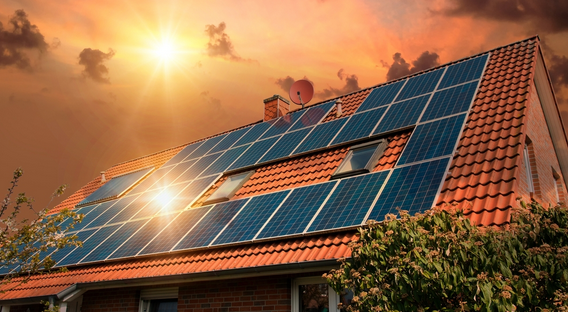
History, Inventors & Today’s R&D
A rooftop solar system (also known as rooftop photovoltaic, or PV, system) refers to a solar energy setup mounted on the roof of a building (residential, commercial or industrial) that converts sunlight into electricity, often connected to the utility grid (net-metering) or sometimes operating in stand-alone mode. Today, these systems are a key part of the global clean energy transition and are increasingly common on homes, apartment blocks, offices, schools, factories, etc.
In this blog we’ll walk through:
- What makes up a rooftop solar system and how it works
- History: from early discoveries to rooftop installations
- Journey of key inventors and milestones
- R&D & recent developments in rooftop solar
- Why rooftop solar matters today
- Conclusion and your call-to-action
1. What Makes Up a Rooftop Solar System & How It Works
A typical residential rooftop solar PV system includes:
- Solar modules/panels (usually crystalline silicon or thin-film PV)
- Inverter (to convert direct current (DC) output of panels to alternating current (AC) for use in the home/grid)
- Mounting/racking structure fixed to the roof
- Wiring, junction boxes, protection devices
- Metering (including net-metering in many regions)
- Optionally battery storage, monitoring systems, etc
When sunlight hits the solar modules, the photovoltaic effect causes electrons in the semiconductor material (typically silicon) to flow and generate direct current. The inverter converts this into usable AC power. If the system is grid-connected and net-metered, any excess power generated can be fed back into the grid (and the homeowner gets credit for it). Over time, the system produces electricity, reduces the home’s reliance on the utility grid, lowers electricity bills, and can reduce carbon emissions.
2. History: Key Milestones in Solar Rooftop Systems
Ancient/Pre-modern precursors
- Long before solar panels, humans used the sun for heat and lighting. According to a timeline from the U.S. Department of Energy’s National Renewable Energy Laboratory (NREL), solar technology has roots back to the 7th Century B.C. (magnifying glasses, mirrors etc). Energy.gov
- The “photovoltaic effect” (light creating electric current) was first discovered by French physicist Alexandre‐Edmond Becquerel (1839) while experimenting with electrodes in a conductive solution. EnergySage+1
19th & early 20th century
- In 1883, American inventor Charles Fritts created what is considered one of the first functional solar cells using selenium coated with gold and installed on a rooftop in New York. His conversion efficiency was only ~1%. Smithsonian Magazine+1
- In 1888, Edward Weston secured U.S. patents (U.S. 389,124 and 389,425) for solar cell apparatus. Smithsonian Magazine+1
- The early rooftop solar arrangement is also discussed in a recent article titled Untangling the Mystery of the World’s First Rooftop Solar Panel, which notes an early rooftop installation by George Cove in 1909. bellingcat
Mid-20th century breakthrough
- In April 1954, scientists at Bell Laboratories in the U.S.—Daryl Chapin, Calvin Fuller and Gerald Pearson—developed the first practical silicon‐based solar cell capable of meaningful power output. This set the stage for modern PV technology. SEIA+1
- During the 1970s, amid energy crises (oil shocks), governments and research institutions significantly ramped up investment in solar R&D and rooftop/solar building research. Virtual Peaker+1
Late 20th and early 21st century: Rooftop adoption
- As PV costs fell, rooftop solar systems moved from niche to mainstream. The idea of “solar roofing” (integrated into roof tiles, or mounted on roofs) was also developed. roof-crafters.com+1
- Over time, rooftop solar systems became more affordable, efficient and widely adopted. For example, the Virtual Peaker article notes rooftop solar modules initially had ~1% efficiency; today residential modules often run 15-25% or more. Virtual Peaker
3. “Who Invented” Rooftop Solar Systems?
There is no single person who invented “rooftop solar systems” as we see them today—these evolved through many decades of scientific discovery, engineering and commercialization. Key contributors include:
- Alexandre-Edmond Becquerel (1839) – discovery of photovoltaic effect.
- Charles Fritts (1883) – one of the first rooftop solar cell installations using selenium.
- Bell Labs team (1954) – practical silicon solar cell.
- Many others: in the mounting, inverters, grid interconnection, etc.
Thus, rooftop solar is the result of layered innovations over time.
4. Today’s Research & Development (R&D) and Emerging Trends
Here are some of the current trends, developments and research areas in rooftop solar systems:
a) Efficiency improvements & new materials
- Researchers are working on perovskite solar cells, organic photovoltaics, multi-junction cells that may push conversion efficiencies higher, or reduce cost. Example: the arXiv paper Organic and perovskite solar cells for space applications (2017) shows how new materials are being tested. arXiv
- The mounting costs have dropped dramatically while efficiencies have improved. Virtual Peaker notes a 99% drop in module cost since the 1980s. Virtual Peaker
b) Integration & building-integrated photovoltaics (BIPV)
- Rooftop solar systems are no longer just panels on racks. They are being integrated into building materials (solar roof tiles/shingles). Example: the “solar shingle” concept, commercialised around 2009-2011 by DOW Chemical. Environment America+1
- Roof design, aesthetic integration and structural considerations are being improved. roof-crafters.com
c) Smart monitoring, IoT, predictive maintenance
- Rooftop systems are now equipped with smart sensors, monitoring systems, remote diagnostics. Example: The research on defect detection in PV panels using UAVs and machine learning (2021) shows how maintenance is evolving. arXiv
d) Policy, grid-integration & rooftop solar adoption
- Regulations are evolving to ease rooftop solar deployment. For example, in India the Karnataka Electricity Regulatory Commission (KERC) in 2025 permitted citizens to install solar panels not just on rooftops but also on walls and elevated structures in apartments/buildings. The Times of India
- Governments are increasingly pushing for rooftop solar in government buildings, apartments and industry. For instance, a recent project in Delhi launched rooftop solar systems on 1,000 buildings to generate ~55 MW and reduce CO₂. The Times of India
e) Cost reductions & business-model innovation
- The cost of rooftop solar has dropped significantly, making rooftop PV financially viable for many homeowners.
- New business models — e.g., leasing, power-purchase agreements (PPAs), community solar (shared rooftop solar) — are emerging.
- Example of community rooftop solar: a 98 kW rooftop PV installation at Aarhus University (Denmark) crowdsourced by students/employees — highlighting the partnership and business-model innovation. arXiv
5. Why Rooftop Solar Systems Matter Today
- Energy independence: Homeowners generate their own electricity.
- Grid relief: Distributed generation on rooftops reduces pressure on centralized grid/ transmission.
- Carbon reduction: Roofs turned into solar power + less fossil-fuel electricity = fewer emissions.
- Financial savings: Reduced electricity bills, often quick payback periods depending on local policies.
- Utilising unused rooftop space: Every building is a potential power plant; rooftops provide area with minimal additional land usage.
- Resilience & future-proofing: With battery storage and smart integration, rooftops become part of resilient energy systems.
6. Conclusion
From the early work of scientific pioneers in the 19th century, through the breakthroughs at Bell Labs in the 1950s, to today’s sophisticated rooftop solar installations and R&D frontiers, rooftop solar systems have come a long way. With advances in technology, policy and cost reduction, rooftop systems are now a practical and attractive option for homeowners and building-owners.
If you’re considering installing a rooftop solar system, now is a great time. The ecosystem is mature, the technology well-tested, and many incentive schemes (including subsidies) make it financially attractive.
🔗 Useful Reference Links
- “A Brief History of Solar Panels”, Smithsonian Magazine. Smithsonian Magazine
- “The Evolution of Rooftop Solar Panels”, Virtual Peaker. Virtual Peaker
- “The Solar Century: Landmark Moments in the History of Solar Energy”, SEIA. SEIA
- “Solar Energy Basics” (NREL) – rooftop device history. NREL
- “Untangling the Mystery of the World’s First Rooftop Solar Panel”, Bellingcat (2023). bellingcat
- “Karnataka Electricity Regulatory Commission permits citizens to install solar panels on walls of apartment buildings”, Times of India (2025). The Times of India
Thank you for taking the time to read this article
📞 Contact: +91 86608 21746
📧 Email:brindavansolutions@gmail.com
🏢 Company: Brindavan Solutions, Bangalore
Interested in solar? Get your free proposal and site survey with just one click! https://wa.me/918660821746
